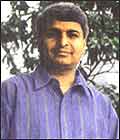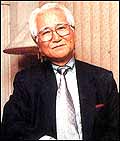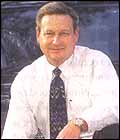













|
PEOPLE
2001 Who Will It Be?
 Every
revolution needs its poster boys. Since 1999, a stream of Indians who've
made it big in the American-tech scene has provided inspiration, paparazzi
fodder, and (sometimes) capital to India's own tech-wannabe scene. It's
great to have poster boys. Everyone wants to read about them. And
everyone, from boardroom generals to tech-challenged politicos are willing
to listen to them. The year 1999 belonged to the man who started it all, Sabeer
Bhatia (observe our maturity in not punning around the name of the
company he founded). There were others before him-like the three Vinods:
Gupta, Dham, and Khosla-but none was as flashy, in a nice mass-market kind
of way, as Bhatia. Y2K had four. Gururaj (Desh) Deshpande of
Sycamore; K.B. (Chandra) Chandrasekhar, the founder of Exodus and
now the CEO of Jamcracker; Sanjeev Sidhu, the low-profile head of
i2 Technologies, and Pradeep Sindhu, the founder of Juniper. Trivia
about the four blossomed in the otherwise arid pages of the pink brigade.
How Deshpande's wife, Jayashree is Infosys Chairman Narayana Murthy's wife
Sudha's sister, making his mother-in-law, arguably, the richest Indian
mil. How angel Kanwal Rekhi assumed Chandra was from the Massachusetts
Institute of Technology, while he was actually from the Madras Institute
of Technology (an assumption that may have had some impact on the eventual
fate of Exodus that Rekhi funded)... Every
revolution needs its poster boys. Since 1999, a stream of Indians who've
made it big in the American-tech scene has provided inspiration, paparazzi
fodder, and (sometimes) capital to India's own tech-wannabe scene. It's
great to have poster boys. Everyone wants to read about them. And
everyone, from boardroom generals to tech-challenged politicos are willing
to listen to them. The year 1999 belonged to the man who started it all, Sabeer
Bhatia (observe our maturity in not punning around the name of the
company he founded). There were others before him-like the three Vinods:
Gupta, Dham, and Khosla-but none was as flashy, in a nice mass-market kind
of way, as Bhatia. Y2K had four. Gururaj (Desh) Deshpande of
Sycamore; K.B. (Chandra) Chandrasekhar, the founder of Exodus and
now the CEO of Jamcracker; Sanjeev Sidhu, the low-profile head of
i2 Technologies, and Pradeep Sindhu, the founder of Juniper. Trivia
about the four blossomed in the otherwise arid pages of the pink brigade.
How Deshpande's wife, Jayashree is Infosys Chairman Narayana Murthy's wife
Sudha's sister, making his mother-in-law, arguably, the richest Indian
mil. How angel Kanwal Rekhi assumed Chandra was from the Massachusetts
Institute of Technology, while he was actually from the Madras Institute
of Technology (an assumption that may have had some impact on the eventual
fate of Exodus that Rekhi funded)...
Almost two months into 2001, and we still
don't have our candidates for this year's poster boys. Any suggestions?
The King Of Kaizen
 He's
a die-hard Indophile who shows up in the sub-continent once in every six
months. And for a man who coined the term Kaizen, Masaaki Imai has no airs
of a management guru. Which is why on his plant visits, the dimunitive
septuagenarian can be seen rolling up his sleeves to check a component, or
ducking under a machine to spot oil leakages. It is this unflagging
commitment to quality that has made Kaizen-a continuous quality
improvement concept, launched only in 1985-one of the most popular and
effective management tools worldwide. Imai was in the capital recently,
where he met some of his clients. His regret? Not enough companies seem
keen to make the arduous journey to world-class quality. Indeed, despite
his near heroic status in quality circles, Imai san hasn't found too many
followers in India. If only corporate India knew what it was missing... He's
a die-hard Indophile who shows up in the sub-continent once in every six
months. And for a man who coined the term Kaizen, Masaaki Imai has no airs
of a management guru. Which is why on his plant visits, the dimunitive
septuagenarian can be seen rolling up his sleeves to check a component, or
ducking under a machine to spot oil leakages. It is this unflagging
commitment to quality that has made Kaizen-a continuous quality
improvement concept, launched only in 1985-one of the most popular and
effective management tools worldwide. Imai was in the capital recently,
where he met some of his clients. His regret? Not enough companies seem
keen to make the arduous journey to world-class quality. Indeed, despite
his near heroic status in quality circles, Imai san hasn't found too many
followers in India. If only corporate India knew what it was missing...
The Josh Man
 Don't
ask too many questions simultaneously. I have limited capacity up here,''
says john fink, Ford India's outgoing Vice-President (Sales, Service and
Marketing), pointing to his head. Of course, the 46-year-old
engineer-at-heart is only joking. Ask him how many parts go into an Ikon,
or the name of the service supervisor in the Agra service station, and
he'd answer without batting an eyelid. But then, you wouldn't expect
anything less from a man who's credited with launching Ford India's
turnaround vehicle, the Ikon. Sure, Fink is fortunate to have a superb
boss in CEO Phil Spender. But the brief with which the ice-hockey
enthusiast Fink landed in India in March 1999 was to ensure the smooth
launch of the Ikon. At last count, there were some 22,000 Ikons on the
Indian roads, and their number could swell to 40,000 this year. Even
Dearborn (Ford's headquarters) agrees that Fink's done a neat job. Which
is why Jacques Nasser, Ford's super-boss, is having him moved back to
Detroit as Director, Commercial Truck Sales and Marketing. What does the
man himself have to say about the move? ''It's difficult to leave,'' he
quips. Must be. Wish you a lot of josh, John. Don't
ask too many questions simultaneously. I have limited capacity up here,''
says john fink, Ford India's outgoing Vice-President (Sales, Service and
Marketing), pointing to his head. Of course, the 46-year-old
engineer-at-heart is only joking. Ask him how many parts go into an Ikon,
or the name of the service supervisor in the Agra service station, and
he'd answer without batting an eyelid. But then, you wouldn't expect
anything less from a man who's credited with launching Ford India's
turnaround vehicle, the Ikon. Sure, Fink is fortunate to have a superb
boss in CEO Phil Spender. But the brief with which the ice-hockey
enthusiast Fink landed in India in March 1999 was to ensure the smooth
launch of the Ikon. At last count, there were some 22,000 Ikons on the
Indian roads, and their number could swell to 40,000 this year. Even
Dearborn (Ford's headquarters) agrees that Fink's done a neat job. Which
is why Jacques Nasser, Ford's super-boss, is having him moved back to
Detroit as Director, Commercial Truck Sales and Marketing. What does the
man himself have to say about the move? ''It's difficult to leave,'' he
quips. Must be. Wish you a lot of josh, John.
|

